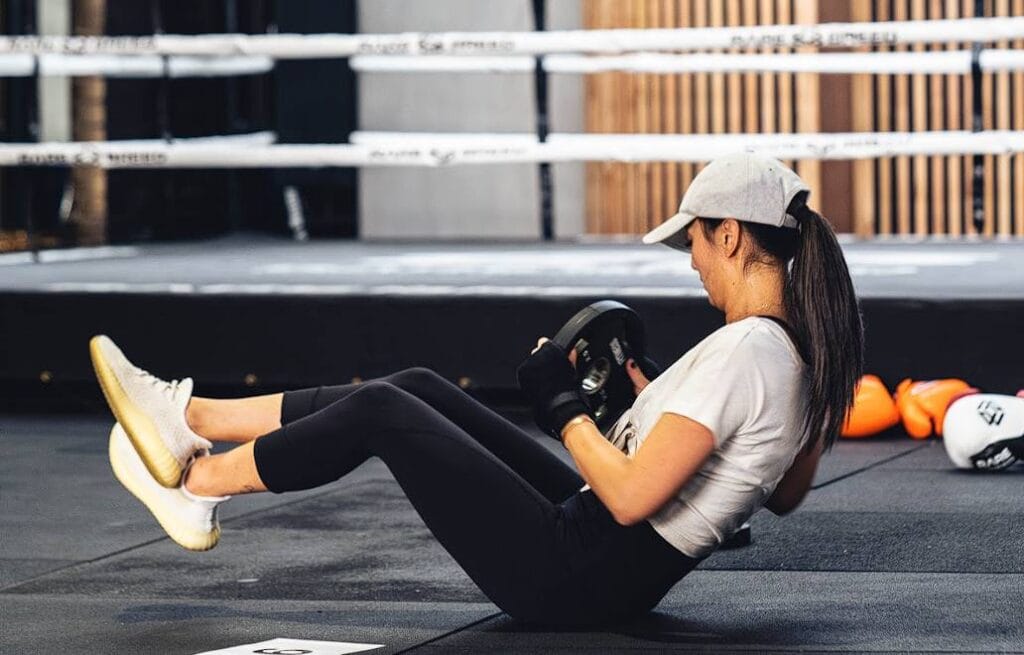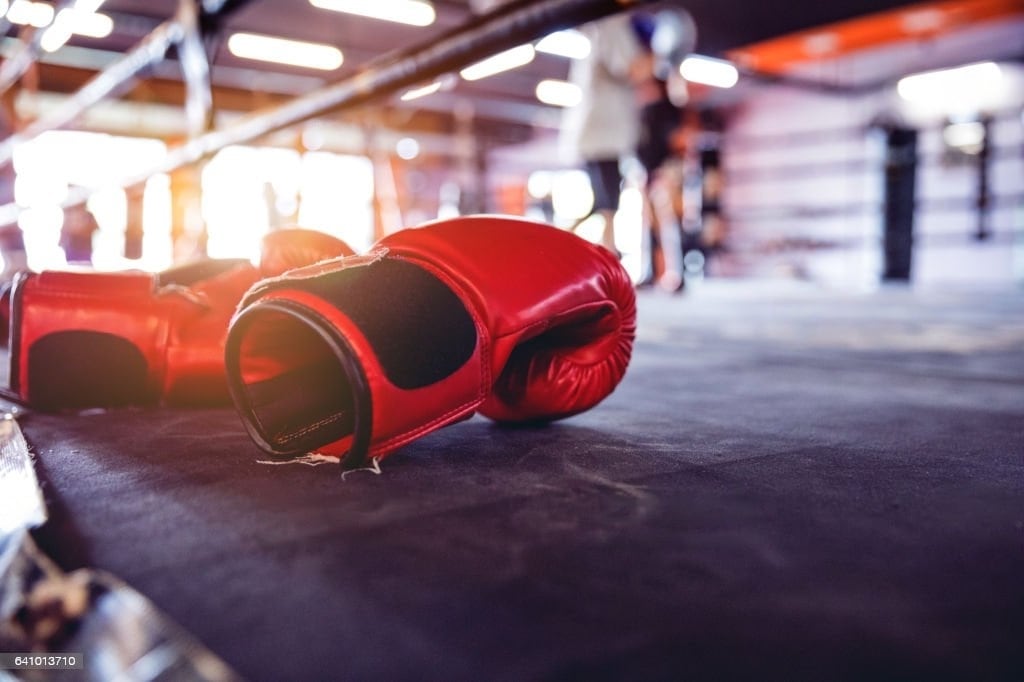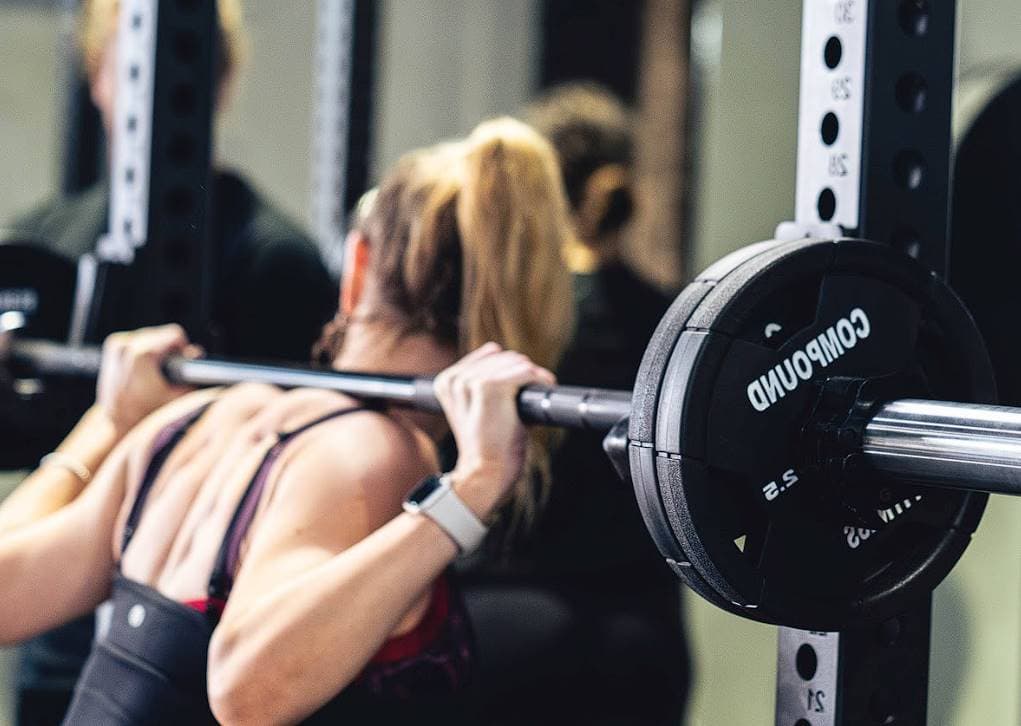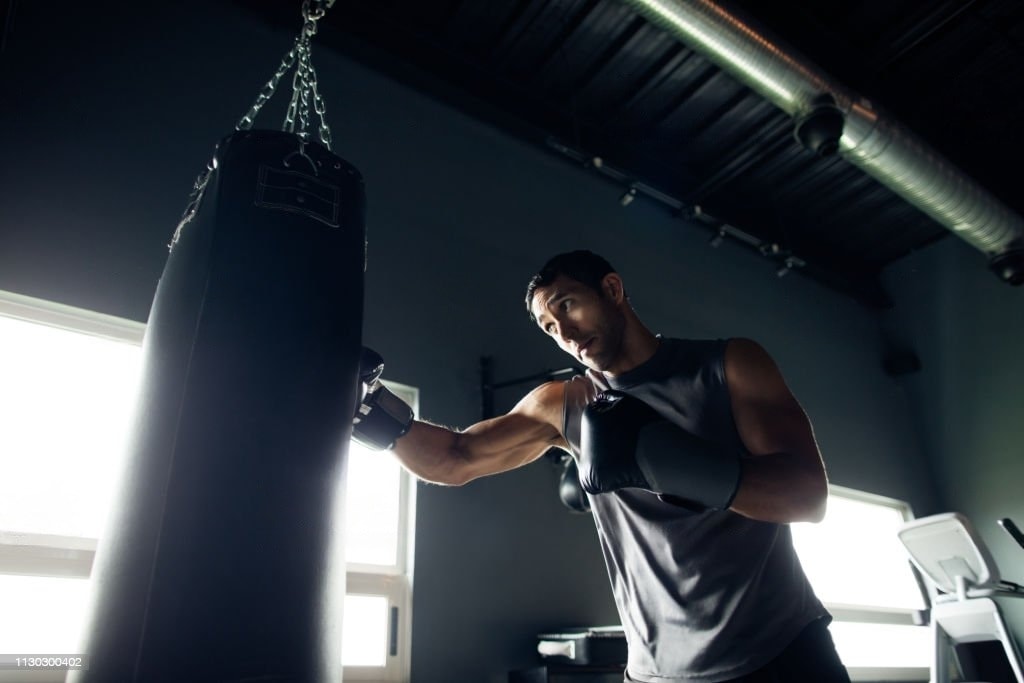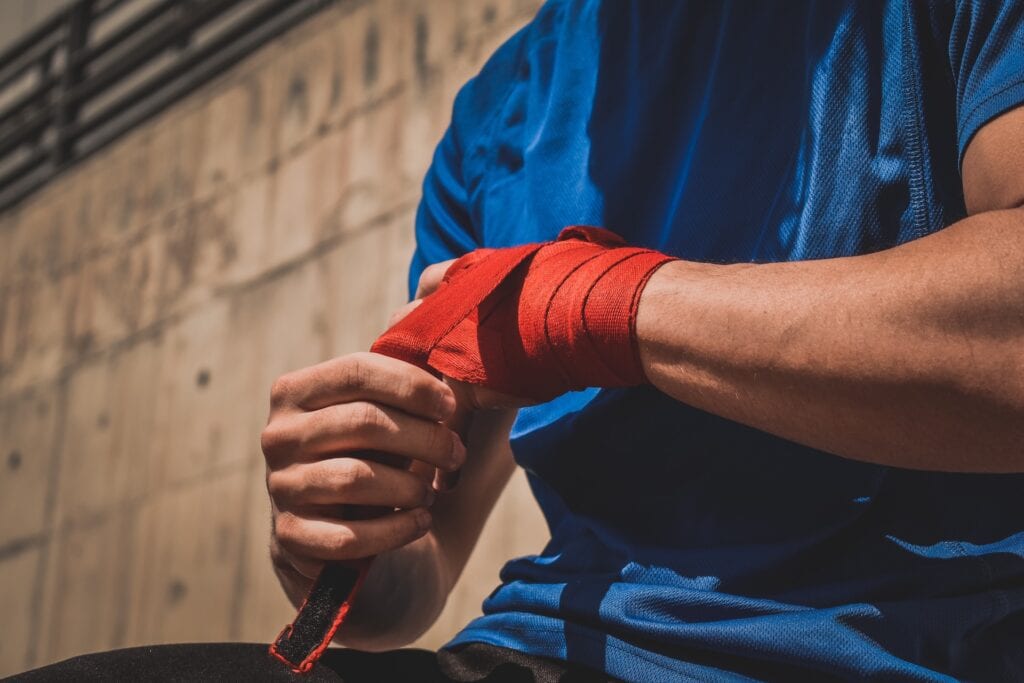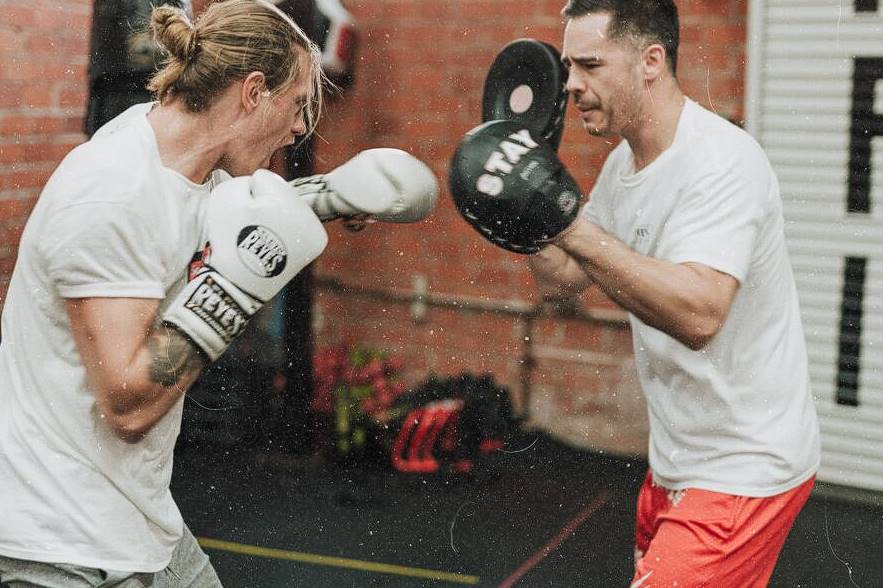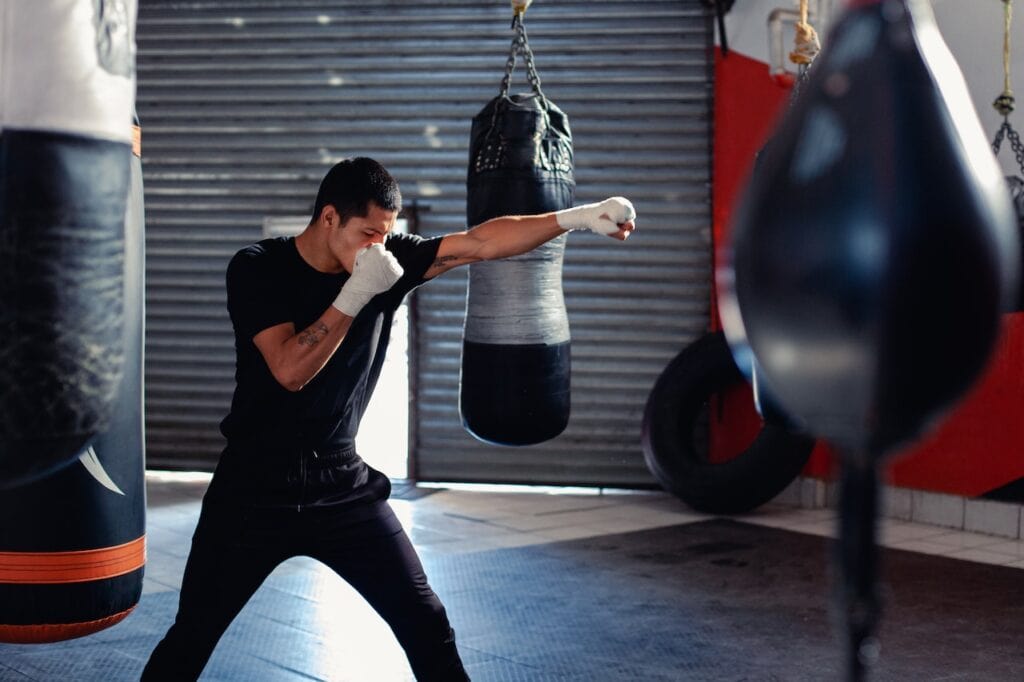If you have ever watched a boxing battle, you know that a boxer must be able to perform quick and powerful motions, such as punching and evading their opponent's punches, for anywhere from 8 to 15 rounds in a fight. In addition, the boxer must be successful.
Because of this, to ensure they have the necessary strength and fitness to win a fight, boxers must engage in a combination of resistance and endurance training when they are training for a match.
The fundamentals of fitness are the same whether you train to become a boxer or get in better shape. Therefore your workout routine should reflect this.
Lifting weights should be your primary emphasis if you want to see improvements in your strength level. Your priority should be to work on your cardiovascular fitness if you want to see improvements in your overall conditioning.
The importance of strength and conditioning in boxing is analogous to chocolate syrup's role in ice cream. You will be in good shape if you don't have it, but if you do, you'll be in a much better position.
Because of this, strength training and cardiovascular exercise can go a long way toward enhancing your explosive power, the quality of your movements, the size of your gas tank, and the integrity of your structure.
The question that needs to be answered is, what are the most effective exercises for building strength and fitness for boxing?
The 8 Best Strength and Conditioning Exercises for Boxing
Eight different exercises are vital components of a successful strength and conditioning program. They are as follows:
- Close Grip Bench Press
- Trap Bar Deadlifts
- Ballistic Medicine Ball Throws
- Dumbbell Rows
- Band Pull Aparts
- Box Jumps
- Road Work
- Power Endurance Training
And when programmed correctly, these exercises will enable you to punch harder, experience improved cardio, move with greater fluidity, and outlast your opponent. So, are you prepared to dive in?
Let's go:
#1 Close Grip Bench Press
Why It’s Great For Boxing: For several reasons, the close grip bench press is an excellent exercise for building strength and fitness in boxing. To begin, it provides a greater focus on the triceps muscles. It implies that it can help you acquire the necessary strength to attain full extension on your punches and add some pop to them as well.
Second, it reduces the amount of stress placed on the shoulder. Because of the sport's rigours, most boxers already have extremely tight shoulders. Therefore this is excellent for them.
Their shoulders are constantly rounded forward, which causes strain in the shoulders and can lead to imbalances if it continues. The close-grip bench press prevents excessive growth of the shoulders, to put it another way.
How to Program It: The bench press with a close grip is a powerful compound exercise that should be utilised in that capacity. It indicates that you should perform fewer repetitions—no more than eight—at a higher intensity level. R
egarding the number of sets, I prefer to stay between three and seven. It, of course, is contingent on the number of repetitions you are carrying out.
Because the close grip bench press is a compound activity, it should be one of the first exercises you practice in a training program. Close grip bench presses can help build strength in various muscle groups.
How to Perform Close Grip Bench Press:
- Take hold of a barbell and space your hands, so they are shoulder-width apart.
- Unrack the barbell while you keep the shoulders pinned down and back.
- Controllably lowering the barbell to a point just below the chest while maintaining good form.
- Explode up.
- Iterate as many times as desired repetitions.
#2 Trap Bar Deadlift
Why It's Great For Boxing: One of the easiest exercises for all kinds of athletes is the trap bar deadlift. However, the movement does not call for a great deal of mobility to execute it well.
The squat is an exercise that requires a good level of mobility to complete, and traditional deadlifts can present challenges to the mobility of some athletes. Still, the trap bar deadlift provides newcomers with a relatively modest entry point.
In addition, it is an excellent builder of the posterior chain. These muscles are located on the back of the body and include the hamstrings, glutes, lower back, middle back, and upper back, amongst other back muscles.
Unfortunately, most boxers have somewhat underdeveloped versions of these muscles, although they significantly contribute to punching power, fluidity, injury prevention, and overall performance.
Athletes typically move the trap bar at a faster average speed than during squats or standard deadlifts, making the trap bar deadlift a more sport-specific variation of the traditional deadlift and squat. Because of this, it is an excellent tool for transferring strength into power.
How to Program It: A heavy compound movement is the trap bar deadlift. It is similar to the close-grip bench press in that regard. It indicates that the workout should be scheduled with low reps (again, no more than eight) and high intensities.
How to Perform Trap Bar Deadlift:
- Position your feet, so they are hip-width apart, and step into the centre of the trap bar.
- Put your hips in a slightly more backward position and drop your butt down to hold the handles in the centre.
- The chin should be tucked in, the shoulders should be pinned down and back, and the chest should be lifted slightly.
- Explosively push away from you on the floor until you reach the lockout position.
- To return the trap bar to its starting position on the floor, you must sink the butt in a controlled manner while also pushing the hips back slightly.
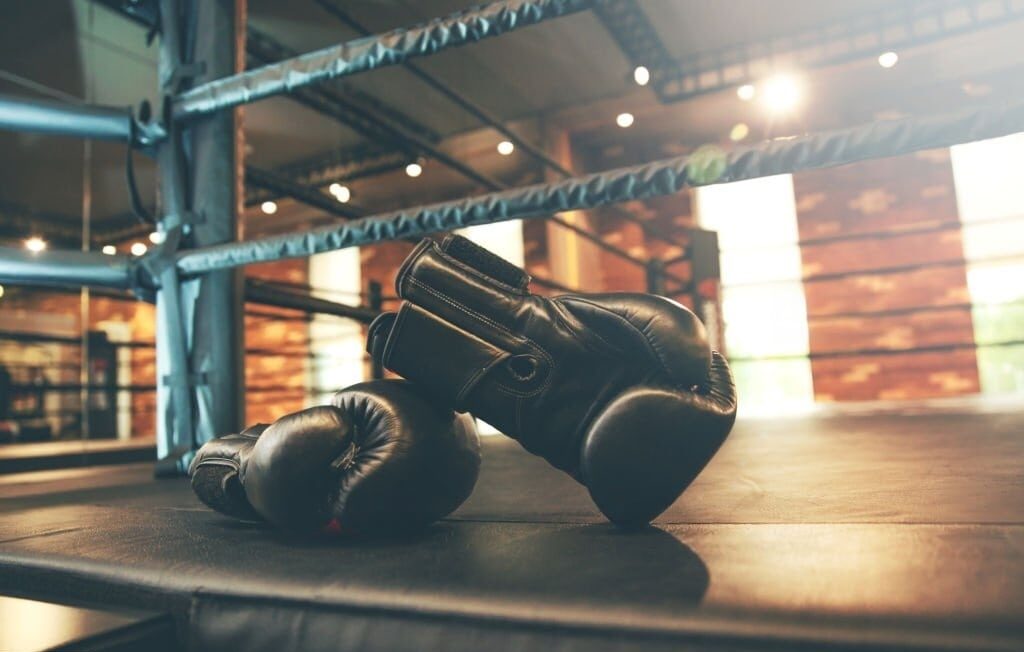
#3 Ballistic Medicine Ball Throws
Why They’re Great For Boxing: One of the easiest exercises for all kinds of athletes is the trap bar deadlift. However, the movement must call for a great deal of mobility to execute it well.
The squat is an exercise that requires a good level of mobility to complete, and traditional deadlifts can present challenges to the mobility of some athletes. Still, the trap bar deadlift provides newcomers with a relatively modest entry point.
In addition, it is an excellent builder of the posterior chain. These muscles are located on the back of the body and include the hamstrings, glutes, lower back, middle back, and upper back, amongst other back muscles.
Unfortunately, most boxers have somewhat underdeveloped versions of these muscles, although they significantly contribute to punching power, fluidity, injury prevention, and overall performance.
Athletes typically move the trap bar at a faster average speed than they do during squats or standard deadlifts straight-arm trap bat is a more sport-specific variation of the traditional deadlift and squat. Because of this, it is an excellent tool for transferring strength into power.
How to Program Them: When it comes to ballistics, I prioritise accuracy over quantity. It indicates you should avoid performing a ridiculously high volume of ballistic medicine ball throws. Instead, you should only do a small number of them with the highest quality and intent, where intent refers to the amount of effort and concentration you put into each throw.
How to Perform the Straight Arm Throw:
- Get a medicine ball and position yourself so that you are square to the wall you will be throwing the medicine ball against.
- Position your left hand on the left side of the ball to support it while you do the movement on your right side. If executing the action on your right side, place your right hand behind the ball.
- Put some weight on your hips by bringing them back.
- Bring the medicine ball down to your right hip as you load your hips, and continue the exercise.
- Extend the hips and transfer the power created from the hips through the upper extremities to hurl the medicine ball against the wall.
- Perform the necessary number of repetitions on both sides.
#4: Dumbbell Rows
Why They’re Great For Boxing: When it comes to boxing, the structure is everything. When I talk about structure, I mean the joints' alignment and the muscles' balance. You are more likely to sustain an injury if your muscles are unbalanced and your joints are out of alignment.
An injury will result in lost time. And time lost implies that your rivals have more opportunity to overtake you in the race.
The row with dumbbells is an exercise that helps grow the back muscles, and it may be used to help you address muscle imbalances in your body. By exercising certain muscles, such as the rhomboids, mid traps, and others, you can lift your shoulders into the correct position, resulting in improved posture.
In addition, the prevention of injuries and the enhancement of your punching power will result from doing this. How? Because you have a greater range of motion, you may generate power.
How to Program Them: Rows with dumbbells are more of an accessory or auxiliary exercise. Although it is a compound exercise, you should execute a larger number of repetitions, anywhere from 6 to 12, and a smaller number of sets (3-4).
How to Perform Dumbbell Rows:
- Begin by taking the dumbbells into both hands.
- Make sure the chest is up, and the chin is tucked in, and then hinge the hips back until the chest is parallel to the ground.
- Take some time to stretch out your lats.
- Push your elbows out past your body's trunk and give it a solid squeeze at the top.
- Please repeat after me as you lower your back down.
#5 Band Pull Aparts
Why They’re Great for Boxing: Pull-apart with a resistance band is another strength and conditioning exercise that can help address joint malalignment and imbalance issues. As was indicated earlier, a significant number of fighters have shoulders that are rounded forward, which weakens their structure.
Band pull parts are great for strengthening the muscles in your upper and middle back, which helps bring your shoulders back into proper alignment. Again, this reduces the risk of damage while also increasing the force of your punches.
How to Program Them: Pull-parts using a band is a form of corrective exercise. One of my favourite strategies in between sets of compound exercises like presses and pulls is to perform high rep ranges (10–20).
How to Perform Band Pull-Aparts:
- To begin, place your hands at the appropriate distance apart and grab a resistance band. The greater the distance between your hands, the easier it will be. Likewise, the further away, the simpler it is.
- Maintain a tall chest, a tight core, and a squeezed-in gluteal position.
- Pull the band beneath your chest and squeeze your shoulder blades together to perform this exercise.
- Proceed cautiously in the direction of the starting place (add a protraction for the more advanced version).
- Iterate as many times as desired repetitions.
#6 Box Jumps
Why They’re Great for Boxing: Boxers who wish to boost their punching strength and their ability to throw powerful punches for the entirety of the fight can benefit tremendously from performing box jumps and any other form of plyometric exercise.
Why? Because box leaps improve your ability to generate force quickly, they are recommended. In addition, box jumps work the lower body, but they also educate the body on how to move force up through the trunk and then out the upper extremities.
How to Program Them: Box jumps and ballistic medicine ball throws are an exercise that ought to be scheduled with quality in mind. Trying to perform box leaps while you are out of breath and can hardly make it onto the box is not a good idea.
Not if your primary concerns are increasing your strength and boxing performance. You should perform between six and ten sets of one repetition, allowing yourself to recover in between sets completely.
How to Perform Box Jumps:
- Position the feet, so they are hip-width apart in front of a secure and raised platform.
- Immediately and slightly tilt the pelvis backward while bending the knees.
- At the same time, bring the arms to your sides.
- To get on the box, quickly stretch the hips and jump up.
- Land gently, absorbing impact with your hips as you do so.
- After finishing the specified number of repetitions, step back down.
#7 Roadwork
Why It’s Great for Boxing: The kind of cardio that involves moving a long distance at a slow speed for an extended period is ideal for creating a fuel tank that can keep you energised for the entirety of about. Even though it is not the only part of endurance training that needs to be addressed, the fact that you do so is still very important to your success.
How to Program It: Roadwork is something that I like to provide to my fighters twice a week for a total of 45 minutes, but this time can change depending on how much endurance training they require.
Check out this blog post if you are interested in learning more about determining the specific needs of your endurance training and seeing an example of a timetable for endurance training.
How to Perform Roadwork: For roadwork, you have several different options available to you. Jogging is by far the most prevalent form. On the other hand, when the bout draws closer, I like to switch my fighters to activities such as biking or swimming to reduce the amount of wear and tear on their legs.
#8 Power Endurance Training
Why It’s Great for Boxing: It would be best if you could be explosive consistently throughout the entire battle unless your strategy is to knock out all of your opponents with a single punch.
Training for power endurance, also known as anaerobic endurance, is necessary for this purpose. This type of exercise aims to improve your ability to maintain high levels of explosiveness for long periods.
How to Program It: I schedule power endurance training twice a week for my fighter, but the specific workouts vary based on their demands.
How to Train for Power Endurance: Interval training is the simplest approach to improving your power endurance and is also the most effective. First, download an interval timer, then set the clock, so it is on for ten seconds and off for thirty seconds.
Next, throw as hard as you can for ten seconds at a heavy bag while in the "on" position. Next, throw soft punches at the bag while you are "resting" between rounds. If you do this for as many as ten repetitions, you'll see an increase in your power endurance.
Strength Training and Boxing Conditioning: The 1-2 Punch for Physical Fitness
The Importance of Strength Training in a Fitness Regimen
People typically think of strength training as lifting incredibly big weights and becoming an enormous bodybuilder. They may also wonder how a boxing instructor could assist them in this domain.
Adding strength training to your fitness routine as a supplement to your boxing courses will not cause you to mutate into the Incredible Hulk. It does not have to take away from the time you spend participating in your preferred sport.
Instead, consider strength training as the act of executing exercises involving some form of resistance, whether that resistance comes from weights, equipment focused on resistance, or even your own body weight.
This type of workout may comprise performing push-ups, sit-ups, squats, or even lifting a dumbbell with a weight ranging from light to medium.
Strength training will strengthen your muscles, joints, and bones, allowing you to improve the quality of your workouts. You will see these benefits if you include strength training in your fitness routine.
Because of this, you will be able to burn more calories throughout the day and tighten up those "problem places" that never seem to get smaller, no matter how much time you spend on the treadmill.
The Importance of Conditioning in a Fitness Regimen
Conditioning puts more of an emphasis on the heart, which is widely regarded as the single most essential muscle in the body. On the other hand, strength training targets the larger muscle groups in your body.
In addition, your boxing strength and conditioning routine can benefit greatly from the addition of high-intensity cardio intervals, which will also provide a welcome change from the constant stream of Instagram photographs you normally post.
Again, consider this from the "quantity" point of view. When you put effort into conditioning, you force your heart to pump a greater volume of blood for a greater distance over a longer time. When you ask your heart to work harder than it is used to (within reason, of course), it strengthens itself. It is true for any other muscle as well.
It indicates that the heart will be able to pump blood and oxygen into your muscles for a longer period the next time you work out. Whether you are performing boxing workouts or moving around outside of the ring, you will be able to put in the hard effort for a longer period.
Exercise is one of many activities that can reap the benefits of this. By elevating your heart rate consistently, you will be able to increase the overall efficiency of your heart even when you are not actively exercising.
How To Use Strength Training and Conditioning To Become A Better Boxer
Now that we have a fundamental understanding of strength training and conditioning, the next question is how we can precisely apply this knowledge to boxing routines.
We are going to talk about a few different ways that you can utilise strength training exercises to improve the quality of your movements as a boxer, and we are also going to talk about a few different tried-and-true ways that you can improve your conditioning to be able to perform as a boxer for longer periods.
Best Strength Training Exercises for Boxers - With Equipment
Even though boxing is primarily about having strong arms and shoulders to deliver powerful punches, the truth is that boxing is a full-body workout, even though we tend to think that boxing is primarily about having strong arms and shoulders.
The power that we produce for our punches comes, in equal measure, from our legs and the strength that we draw from our core rather than just our upper bodies.
Because of this, any strength training program's primary emphasis should be placed on the larger muscular groups found throughout the human body, such as the thighs, glutes, and abdominals, in addition to the chest and shoulders.
Here is where the traditional resistance workouts, including squats, the deadlift, lunges, the bench press, and other movements along these lines, will benefit you most. In addition, it would help if you focused on exercises that target many muscle groups simultaneously since this will better prepare your body for the demands placed on it when boxing.
The purpose is not to increase your muscle mass and appear to have a bodybuilder's physique. Nevertheless, you are free to pursue that objective if you choose.
Choose a weight that makes the exercise a little bit more challenging while still allowing you to perform 6–10 repetitions of that exercise in a given set. Instead of worrying about lifting heavy weights when performing these exercises, choose a weight that makes the exercise a little bit more challenging.
Best Strength Training Exercises for Boxers - Without Equipment
Even if you want to focus on strength training but need access to weight training or aren't interested in it, you still have a lot of different options available to you. You will, after all, always have access to the weight that is the finest potential option available: your body weight.
Instead of hitting the weight room, boxers say they prefer the traditional strength-based training from back in the day.
So instead, they will focus on performing traditional bodyweight exercises such as push-ups, sit-ups, and crunches, as well as plyometrics such as jump rope and burpees as part of their routine.
Because these are tried-and-true methods of improving core and general body strength using only your body weight, you can always include them in your training program. As a result, you will always see improvements in both your core and body strength.
Best Conditioning Exercises for Boxers - With Equipment
The conditioning for boxing is comparable to the conditioning for any other fighting sport. Jumping rope is one of the essential workouts for boxers because it is so important for their overall conditioning.
Because it gets your heart rate going and also because it emphasises the need to have good footwork and stay light on your feet, which are both essential for boxers, almost every boxer, regardless of their level of skill, will jump rope when warming up and getting ready for more specific boxing-related exercises.
It is because jumping rope gets your heart rate going and emphasises the need to have good footwork and stay light on your feet.
Plyometrics is a type of workout that include jumping rope and other similar activities. Plyometrics teaches your body to exert power through movement to achieve maximal force in the shortest amount of time.
Plyometrics are notoriously challenging exercises, but they can do wonders for your legs, especially your ankles and knees, as your training progresses. In addition, plyometrics are an excellent complement to the many interval training circuits and routines available.
After you have warmed up, it is time to progress to the boxing-specific exercises you will be doing. If you have access to a punching bag, also known as a "heavy bag", you should put on your gloves (do not hit the bag with your bare fists; you need proper wrapping to support your wrists) and begin practising your punches and stringing them together into combinations. Again, if you have access to a punching bag, also known as a "heavy bag", you should put on your gloves.
The speed bag is another useful piece of equipment that will increase your heart rate and help you practice maintaining your hands by your head because you'll need to have them close by to hit the bag.
If you want to improve your boxing skills, consider investing in a speed bag. If this is your first time working out with a speed bag, feel free to approach any Gloveworx coaches and ask them to instruct you on how to use one. They'd be more than pleased to hand you one over!
Participate in some traditional shadow boxing if you need access to the necessary equipment or prefer to hone your abilities without using a punching bag. Place yourself in the beginning position before a mirror, with your knees bent ever-so-slightly and in a powerful boxing stance.
Give yourself room to experiment with different combos, fight an imaginary opponent, and adjust your form. Even seasoned boxers regularly include shadowboxing in training routines, although beginners might think it's ridiculous to do so.
Best Conditioning Exercises for Boxers - Without Equipment
Going for a run outside is one of the simplest ways to improve your physical condition because it does not require using any exercise equipment. Many serious runners will tell you that they receive greater exercise when they run outside for a given amount of time instead of jogging on a treadmill for the same amount of time.
It is because jogging on a treadmill, which always has the same surface and the same slope, doesn't provide as much of a challenge to your muscles as running outside on various surfaces, including inclines and declines. Therefore, outdoor running is a lot more effective way to condition your muscles.
In addition, it is necessary to include some high-intensity interval training by including times of intense effort. Anaerobic conditioning uses the anaerobic energy system to improve an athlete's speed and endurance. Athletes from all over the world use this sort of training to help them improve their speed and endurance.
For example, suppose you include high-intensity interval training in your boxing conditioning regimen. In that case, you will be able to hit the heavy bag with more intensity, last longer when sparring with an opponent, and improve your speed during footspeed drills. Additionally, you will be able to hit the heavy bag with more intensity.
Shadowboxing is another fantastic technique to condition yourself in the manner that a boxer would, and it requires nothing more than yourself and sometimes a mirror. Shadowboxing is an excellent way to get in shape.
You may condition yourself to go through numerous rounds of punching without having to be in the boxing ring or the gym if you engage in shadow boxing. It is because shadowboxing mimics the movements you'd ordinarily do in a boxing match.
The 6 Best Boxing Conditioning and Strength Workouts for All
If you want to improve your boxing game and are looking for some of the best strength and conditioning workouts, we have some incredible ones that can help you achieve your goals.
1. Burpees
The exercise known as burpees may look easy, but it isn't easy, which is perhaps why not a lot of people look forward to practising them. However, if you can complete this exercise, it is a good sign that your physical fitness levels are high.
In addition, boxers get a fantastic boxing fitness workout out of burpees, which is just one of the numerous ways this exercise is advantageous.
Your shoulder muscles, biceps, and triceps will get a workout when you do burpees, and as a result, your explosiveness will increase, your core will be shredded, and your stamina will be boosted.
Burpees are an excellent full-body exercise that not only quickly raises your heart rate but also helps you improve your cardiovascular strength and build endurance.
The following is the correct way to perform burpees to get the most out of them:
- Begin in a squat position with your feet shoulder-width apart and your knees bent. Maintain this stance throughout the exercise.
- Put your hands on the ground in front of your feet, palms facing inward.
- While completing a push-up, keep your weight distributed evenly across your hands and press your feet backward.
- Carry out a push-up and ensure that your back is correctly aligned by keeping a straight line from your head to your heels.
- To perform a frog kick, jump and land with your feet in the position they were in before you jumped.
- Stand up and quickly jump while simultaneously bringing both arms above your head.
- After you have landed, immediately get into the starting squat position so that you may begin the next burpee.

2. Deadlifts
Boxers would benefit greatly from engaging in any activity or routine that emphasises their abdominal or core muscles for conditioning.
The finest workout for boxing fitness is deadlifting since it helps you build strength in your lower back and core and activates your glutes and hamstrings, making it the ideal exercise.
To execute this boxing conditioning workout, follow the steps listed below.
- Stand with your feet shoulder-width apart, and your toes pointed forward. Next, load the barbell with the desired amount of weight. The loaded barbell should be resting on your shoelaces when you look down. Position it so that it is.
- Raise the heavy barbell to your waist by slightly bending your knees and pulling your abs toward your spine.
- To complete one repetition of this exercise, bring the weight up to your waist, press your hips forward, and lower it so that it is at the level of your mid-shin.
- Repeat.
3. Push-Ups
You could be forgiven for thinking that push-ups are a relatively simple form of exercise, but they are exceptional in conditioning and strength. The more push-ups you do, the more toned and fit your body will become.
Because it strongly emphasises the arms, shoulders, and chest, this exercise is an essential component of the conditioning and strength training that a boxer must undertake.
The endurance of a fighter's arms is of critical significance because it contributes to improving impressive speed and explosiveness, both of which are necessary for knocking out opponents when competing.
The following is the correct way to perform push-ups so that you get the most out of them:
- Get down on your hands and knees and position your hands, so they are slightly wider apart than your shoulders.
- The arms and legs should be held in a straight position.
- Reduce the height of your body to the point where your chest is almost touching the ground.
- After a little pause, lift yourself by straightening your back.
- Repeat.
4. Pull-Ups
Pull-ups are an essential component of any conditioning and strength training program, just like any other exercise. They are fantastic for activating the upper back and improving upper-body strength, and they are recommended for this purpose.
Additionally, this exercise is fantastic for developing pull motion because it can be utilised in various clinching scenarios throughout a boxing bout.
Pull-ups are one of the most challenging exercises for conditioning because it takes enormous strength to do even a single repetition of them. Nevertheless, its use of it as a boxer is impossible to deny.
The following is a description of the correct method for performing pull-ups:
- To begin, place both hands on the bar with your palms facing forward and shoulder-width apart.
- To assume the starting posture, bring your arms above your head, bend your body slightly at the waist, and thrust your chest forward.
- While exhaling, lift your body towards the bar by utilising your back until it is at chest level. Continue doing this until the bar is at chest level.
- As you slowly bring your body back to the beginning position, take a deep breath in.
- Repeat.
5. Jump Rope
Pull-ups are an essential component of any conditioning and strength training program, just like any other exercise. They are fantastic for activating the upper back and improving upper-body strength, and they are recommended for this purpose.
Additionally, this exercise is fantastic for developing pull motion because it can be utilised in various clinching scenarios throughout a boxing bout.
Pull-ups are one of the most challenging exercises for conditioning because it takes enormous strength to do even a single repetition of them. Nevertheless, its use of it as a boxer is impossible to deny.
The following is a description of the correct method for performing pull-ups:
- To begin, place both hands on the bar with your palms facing forward and shoulder-width apart.
- To assume the starting posture, bring your arms above your head, bend your body slightly at the waist, and thrust your chest forward.
- While exhaling, lift your body towards the bar by utilising your back until it is at chest level. Continue doing this until the bar is at chest level.
- Take a deep breath as you slowly bring your body back to the beginning position.
- Repeat.
6. Agility Ladder
Boxers benefit in various ways by performing the agility ladder, another exceptional exercise that is also quite frequent among boxers. You may utilise this workout to your benefit in various ways, including strengthening your lower body and legs, increasing your footwork, and enhancing your coordination.
Enhancing one's footwork is one of the primary factors that decide how successful one will be in boxing contests. Therefore, it is regarded as a fundamental component of boxing training.
Workouts on an agility ladder are excellent for rapidly elevating the heart rate and burning many calories. It indicates that you can do this workout to lose weight and grow leaner. Additionally, you will be able to move more freely around the ring due to this training.
These are some of the most beneficial agility ladder exercises; you should work them into your strength training and conditioning routine.
- Movements in both the forward and backward directions
- Side-to-side stepping.
- Two paces to the front, then one stride to the back.
- Assaulting from the front.
- 1-2 hook, step left.
- The count of 1-2 will move onward.
- 1-2, step right.
Conclusion
In amateur boxing, you will witness more than just strength and conditioning training during the workouts. It is also typical practice in training Muay Thai and mixed martial arts.
It is because every boxer worth their weight in salt knows that training involves more than just hitting a punching bag. Rather, it involves improving every element of your life to increase your performance in your sport.
Most of the time, motivation is not the problem most individuals have. Because we want to reap the benefits of a healthy physique and have a positive outlook on our appearance, we are prepared to put in significant effort at the gym and make smart food choices at home.
Unfortunately, because there is so much confusing and contradictory information, we are frequently led astray regarding the most effective means of achieving our fitness or boxing objectives. However, it is optional for things to be in this state.
It doesn't matter if your goal is to become a professional boxer, improve your performance as an amateur boxer or boost the overall quality of your workouts; the most important thing is to include exercises in your routine that are geared toward improving your boxing strength and conditioning.
Frequenly Asked Questions
How often should I incorporate strength and conditioning exercises into my boxing training routine?
To optimize your boxing performance, it is recommended to incorporate strength and conditioning exercises into your training routine at least three to four times per week.
However, the frequency may vary depending on your current fitness level, training goals, and schedule. It's important to strike a balance between strength and conditioning work and actual boxing training to avoid overtraining.
Should I focus more on cardio or strength training for boxing?
Both cardio and strength training are essential for boxing. Cardiovascular endurance is crucial for maintaining a high work rate throughout the fight, while strength and power are necessary for generating knockout punches and resisting opponents' blows.
It's important to strike a balance between the two. Focus on improving your overall conditioning through cardio exercises like running, cycling, or circuit training, while also incorporating strength exercises that target the muscles used in boxing.
Can strength and conditioning exercises help prevent injuries in boxing?
Yes, strength and conditioning exercises can play a vital role in injury prevention for boxers. By strengthening the muscles and improving flexibility, you can enhance joint stability and reduce the risk of strains, sprains, and other common boxing injuries.
Additionally, a well-rounded conditioning program helps develop core strength, which provides better protection for the spine and helps maintain proper posture during training and competition.
Can strength and conditioning exercises improve punching power?
Absolutely! Properly designed strength and conditioning exercises can significantly improve punching power. By focusing on exercises that target the lower body, core, and upper body muscles used in boxing, you can enhance your ability to generate force and transfer it efficiently into your punches.
Squats, medicine ball throws, plyometric exercises, and resistance training are all effective methods for increasing punching power over time. However, it's important to combine these exercises with proper technique training to maximize your punching effectiveness.
How long should my strength and conditioning workouts be for boxing?
The duration of your strength and conditioning workouts for boxing depends on various factors, including your training goals, fitness level, and available time. Ideally, a session can range from 45 minutes to an hour, allowing sufficient time for warm-up, targeted exercises, and a cool-down.
However, the key is to focus on the quality of your workout rather than solely on the duration. Intensity, proper form, and consistency are more important than simply spending a certain amount of time. Tailor your workouts to fit your schedule and make the most of the time you have available.
